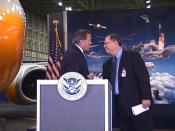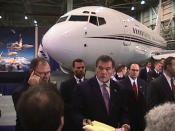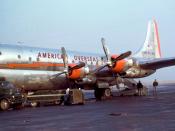Boeing, a well know name in the airplane industry and the worldÃÂs largest aerospace company, was beginning to lose its share of the market in 1997 when Philip M. Condit was elected Chairman and Chief Executive Officer of the company (Biographies). His plan was to use cutting-edge technology to expand the range of products and services offered, taking Boeing to the next level in the business world (Parker).
The new focus of the company was to create three key operating units. These units would consist of commercial airplanes, military aircraft, and space and communication (Holmes, Matlack, Arndt, and Zellner, 471). The new focus also brings with it new transformational leadership. Condit plans to appoint the head of each unit with a new CEO title. This will allow each to operate his/her own division as an independent business (Holmes, Matlack, Arndt, and Zellner, 471).
This newly appointed responsibility would allow his subordinates to recognize that they to have power to implement change in the company as well as to identify the level of importance their position holds.
Taking ownership of units, allows each to see the need to work for the greater good and growth of the organization, not just for their own personal gain.
It will then be up to Condit to follow through on his plans by supporting and encouraging his teams to create and apply new ideas for innovation and productivity. His 35 plus years in Boeing operations and management as well as his extensive educational background in engineering will provide his employees with a vast working knowledge of the company (Biographies). His experience will allow him to teach his subordinates a means by which to recognize potential problems and/or barriers for success; with this identification of possible obstacles will also come the edification of ideas and...


